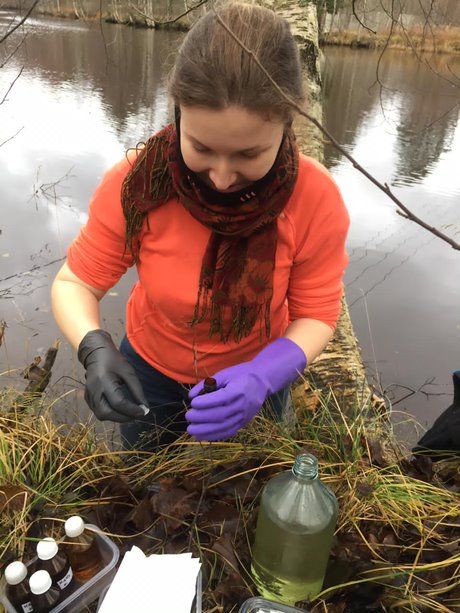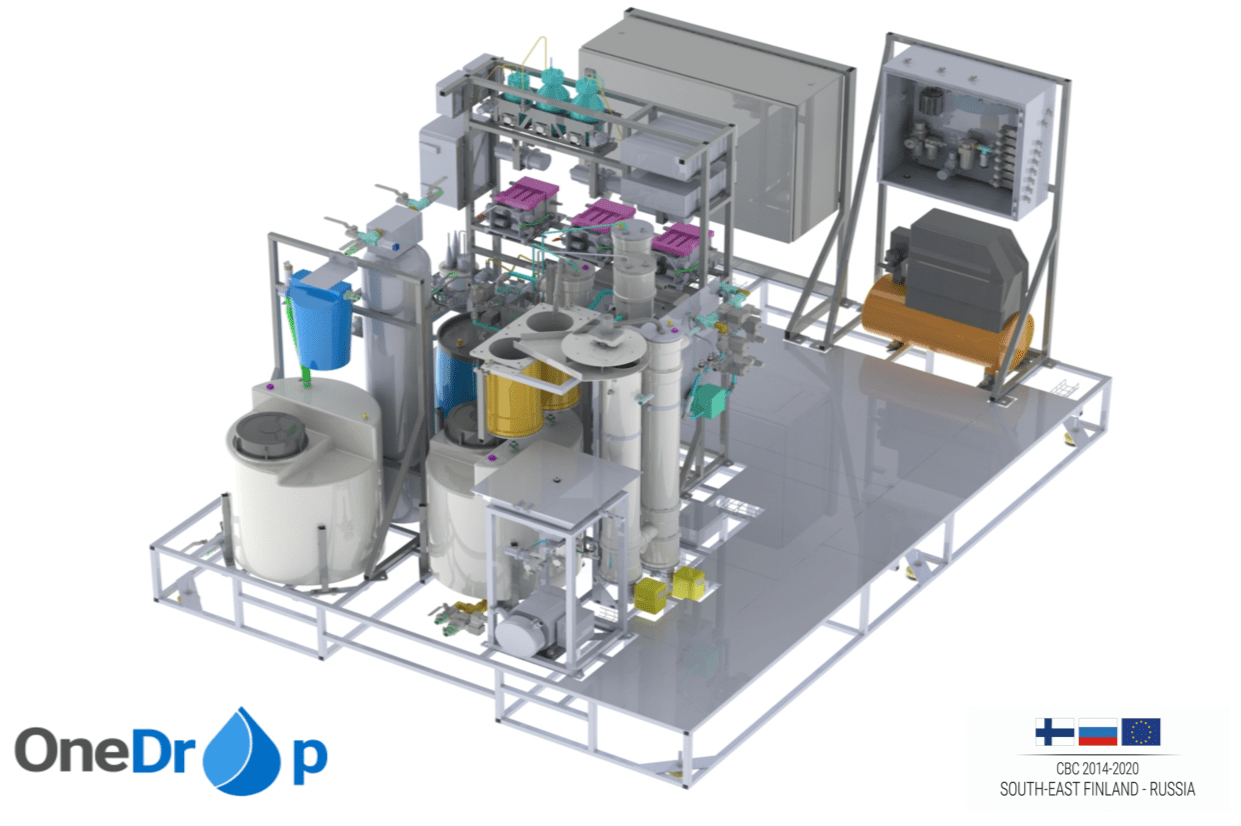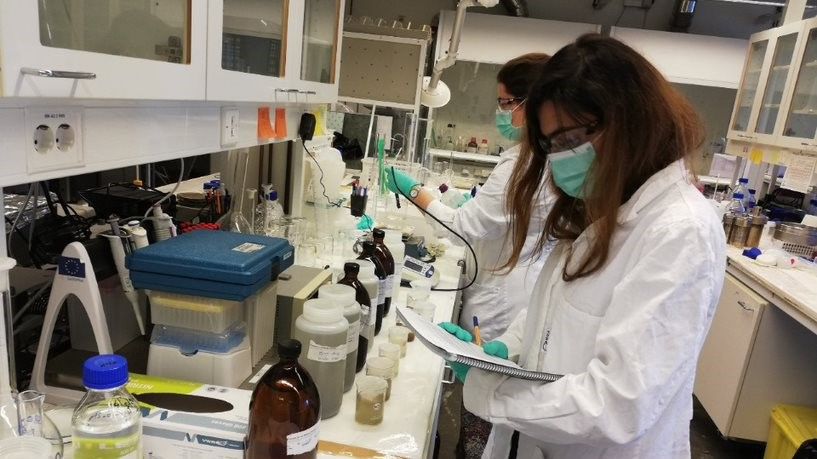Cleaning tons of wastewater with “OneDrop”
Traditional water treatment systems are usually costly and sometimes not very safe for the environment: they use potentially toxic elements such as chlorine, or expensive techniques like ultra-violet light. The OneDrop project is developing a new water purification system based on a key element that is cheaper and safer: sodium ferrate. This is a very active oxidizing agent, capable of cleaning huge amounts of water even if injected in very low quantity. In addition, the project is making this purification plant mobile, potentially able to reach everywhere. The OneDrop project – implemented in the framework of the South-East Finland Russia CBC programme – is already catching media attention: it promises to be a real revolution.
How does it work? Why has it not been done before? According to Hamid Roozbahani, project manager, engineer and professor at the LUT University (lead partner, Finland), the ferrate oxidation technique has been largely studied in laboratories, and its novelty here is the usage. Normal water purification plants consist of a three-stage process: pre-filtration, purification and post-filtration. The OneDrop project uses ferrate sodium in the intermediate stage, where other methods use potentially toxic components or expensive techniques.
“Sodium ferrate contains FE6, a very active oxidization component, interested in bonding with dirty particles in water, coming from bacteria, viruses, organic matter or even heavy metal components”, – explains Mr. Roozbahani. “When these bonds take place, the pollutant particles move either to the bottom or to the top of the water tank, and we can remove them to obtain cleaner water. Afterwards, the treated water passes through an extra filtration unit, and can be cleaned up, even becoming drinkable”.
But the innovation does not stop here. FE6 is a very unstable component, if you leave it on a table for one hour, it will break apart and become useless. “This inconvenience is overcome if we produce the oxidizing component exactly where we need it – continues Mr Roozbahani – So we have created a sodium ferrate generator that we integrate into the purification plant”.
 The sodium ferrate generator – no bigger than a microwave – produces the oxidizing component in real-time and in situ, so it can be injected into the wastewater tank immediately. The generator, which was 3D printed by NPK OMEGA – one of the project’s partners – can produce up to 50 grams of sodium ferrate per litre in one day. “The beautiful thing is that we only need a small quantity to clean a large amount of water”, – exclaims Hamid.
The sodium ferrate generator – no bigger than a microwave – produces the oxidizing component in real-time and in situ, so it can be injected into the wastewater tank immediately. The generator, which was 3D printed by NPK OMEGA – one of the project’s partners – can produce up to 50 grams of sodium ferrate per litre in one day. “The beautiful thing is that we only need a small quantity to clean a large amount of water”, – exclaims Hamid.
Now, project partners are building the whole water purification unit into a trailer, to drive it wherever it is needed. A mobile water purification plant can be used, for example, to clean the ships’ ballast water. From 2025 onwards, discharging ballast water from abroad in EU waters will be forbidden: the water treatment plant can be driven to the port and moved from one ship to another, to treat the ballast waters before these reach the sea… The possibilities seem unlimited.
 But this is only one of the practical uses that the team is exploring. After countless water sampling tests and experiments, the OneDrop water purification plant has proved to be effective when dealing with many kinds of pollutants: from the pharmaceutical contaminants of the Rakkola river (an important, waterway shared by Russia and Finland), to the toxic waters of the Krasny Bor waste landfill, often called the “chemical Chernobyl”. Project scientists were also testing the impact of ferrate sodium on agriculture fields. Tons of soil were bought and polluted in the laboratory and then treated in the purification plant, to arrive at very interesting results.
But this is only one of the practical uses that the team is exploring. After countless water sampling tests and experiments, the OneDrop water purification plant has proved to be effective when dealing with many kinds of pollutants: from the pharmaceutical contaminants of the Rakkola river (an important, waterway shared by Russia and Finland), to the toxic waters of the Krasny Bor waste landfill, often called the “chemical Chernobyl”. Project scientists were also testing the impact of ferrate sodium on agriculture fields. Tons of soil were bought and polluted in the laboratory and then treated in the purification plant, to arrive at very interesting results.
Ultimately, the OneDrop team will provide water treatment solutions for the sewage system of Lappeenranta city and for the Lake Saimaa; and it is collaborating with Vodokanal, the company managing the water channels in St. Petersburg, to test OneDrop system in the city water ways. But the concept of OneDrop is not limited to this project: the benefits of the innovative technique have spread and risen the interest of other stakeholders. In fact, thanks to this initiative, two more projects are now in the pipeline, one specialising precisely in ships’ ballast water, and the other one focusing on cleaning oil spills in the sea. This clearly shows that the OneDrop project is not to end here, rather its benefits will be used in the near future.
 The project is also catching the attention of several media channels, while the website is getting more and more views. When explaining the achievements, Hamid is enthusiastic, and very proud of the international, young team put together by this CBC initiative. In March and May the best experts in the field of water purification will get together for two workshops. The secret of the success is also in the partnership: the team counts on a lot of talented researchers from the top-notch universities of the region, the Finnish LUT, but also the Russian “Peter the Great Polytechnic University” – where the concept of the project was born – and the State University of St. Petersburg. Results and benefits are there, and will live beyond the project lifespan, improving lives of border communities across the two regions.
The project is also catching the attention of several media channels, while the website is getting more and more views. When explaining the achievements, Hamid is enthusiastic, and very proud of the international, young team put together by this CBC initiative. In March and May the best experts in the field of water purification will get together for two workshops. The secret of the success is also in the partnership: the team counts on a lot of talented researchers from the top-notch universities of the region, the Finnish LUT, but also the Russian “Peter the Great Polytechnic University” – where the concept of the project was born – and the State University of St. Petersburg. Results and benefits are there, and will live beyond the project lifespan, improving lives of border communities across the two regions.

